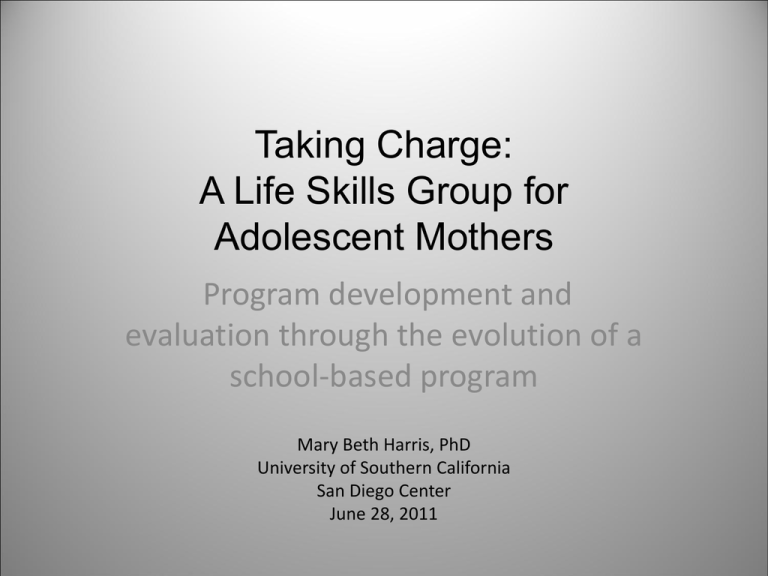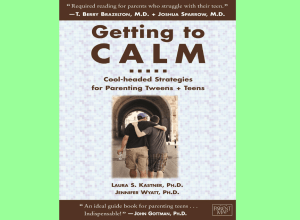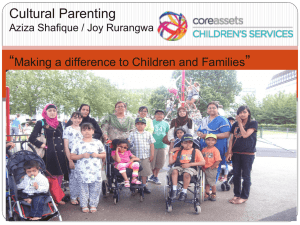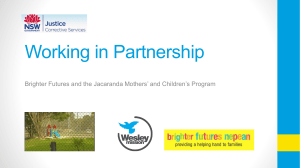Taking Charge: A Life Skills Group for Adolescent Mothers
advertisement

Taking Charge: A Life Skills Group for Adolescent Mothers Program development and evaluation through the evolution of a school-based program Mary Beth Harris, PhD University of Southern California San Diego Center June 28, 2011 Getting Started: Developing the Program Should Inform the Evaluation 1. 2. Why this program is important. What is the problem? What contributes to the problem, who is affected, what are the consequences for those affected and for society. 3. Programs & practices that target the problem and evidence that shows these programs and practices are effective. 4. Goals for the local program or practice. What parts of this problem you plan to impact. 5. Specifics of your program - what it involves and how it works. 6. Why your program should work – the change process. 7. Evidence that says this program should be effective with the students, families, etc. at your school. 8. Who needs to be involved and what they will each be doing. 9. Time required to develop, prepare, and present the program. 10. Cost of the program in actual $$ and in resources. The History of Taking Charge A call from school social workers on the U.S.-Mexico border for help with keeping teen mothers in school and helping them to graduate. THE PROBLEM WHY IS THIS IMPORTANT? 1. School Dropout 60% of pregnant and parenting students drop out of school and do not graduate. Attendance & grades predict dropout. Attendance drops 30% with pregnancy. Attendance directly impacts grades. 2. Poverty • Women who give birth before age 20 are 10 times more likely to live in poverty with their children. • 54% less likely to have a high school diploma, GED, or career training by 20. • 62% less likely to sustain jobs with adequate pay through adult life. 3. Consequences for children of adolescent mothers • 25% more likely to have developmental problems. • More frequently fall behind in school. • More often have behavioral problems. • Boys more likely to be incarcerated • More likely to become teen parents. Review the Literature to find… • • • • • • What causes the problem What research recommends to be done What programs are already being done What evidence shows that these work Explanations for why they should work How they DO work – what features do the best ones have in common? A lit search highlighted four challenging domains for teen mothers Education Relation ships Career Parenting 9 School Challenges • Stigma with teachers • Isolation, loss with peers • Demands of parenting and childcare • Conflicting school & home requirements Personal Relationships: Challenges and Needs Family members, particularly mothers Father of baby Father’s family Friends and peers Parenting • Knowledge of child development is linked to child neglect and abuse. • Childcare skills are linked to the quality of mother-child bonding. • Parenting efficacy, a sense of parenting competence, impacts overall child adjustment. Career Planning: Too soon to care? • Teen mothers & their children are 10 times more likely to live in poverty. • Early career preparation predicts economic self-sufficiency in adult years. • Career planning in adolescence earns 45% more over a lifetime. Components of best programs & practices addressing these areas • • • • • Social skills-building Delivered in groups Task-centered A cognitive-behavioral base Developmentally appropriate What adolescent issues are these programs targeting? • • • • • • school drop-out transitioning out of foster care physical & developmental disabilities immigrants & refugees incarcerated youth substance abuse & addiction Teen pregnancy? Generally not. What kind of programs DO focus on adolescent mothers? Programs to inform and train teen mothers on childcare, nutrition, child development, sexuality, STDs. None focused solely on mastering skills that support school achievement, personal relationships, parenting efficacy, or career development. Skills-Building Approach • Considering the 4 areas of challenge for teen mothers - and • Considering how these fit with those targeted by skills-building interventions, • I focused on skills-building with teen mothers in developing Taking Charge Program Goals & Objectives Program Goal: To strengthen skills and behaviors in pregnant and parenting students that will increase school retention and high school graduation. Program Objectives: 1. To improve academic achievement 2. To improve problem-solving skills 3. To increase active coping skills What kind of program can best achieve these goals? • • • • • • • A strengths-based approach Developmentally relevant A cognitive-behavioral explanation A group format Based on social learning theory Using a task-centered model 8 to 12 sessions A strengths perspective assumes … • Teen mothers need immediate life skills that most of us master in our twenties. • Need for experience and skills is the root of most problems that young mothers confront, rather than personal deficits. • Adolescent mothers can master skills to manage their roles as students, parents, providers. Developmental Theory says… Adolescents are only beginning to develop the skills they will need as adults. Pregnancy compounds the developmental tasks of adolescence; it does not replace or resolve them. Adolescent mothers are still adolescents. Cognitive Behavioral theory explains behavior… 1. How we perceive and understand things determines how we act and react. 2. People cope with problems by (A) Avoiding or ignoring them (B) Accepting & adjusting to them (C) Actively trying to resolve them 3. We develop life skills by observing others, practicing, and mastering. Research on coping shows… • People who believe they can change things are more likely to take action. • Adults tend to take action. • Adolescents & children tend to avoid or adapt and accept. • Taking action leads to better results. Benefits of a Task-Centered Group • Cognitively: Participants experience how their own behaviors link to managing their problems. • Behaviorally: They gain practice in trying out and mastering new behaviors and skills. • They can practice new skills in the context of a safe peer group. The Change Process: How it all works 1. Self-identify goals in school, relationships, parenting, career. 2. Practice new behaviors by performing self-appointed tasks. 3. Plan and practice tasks in the group, and also review the results. 4. Develop active coping and problemsolving skills, which promotes selfefficacy. Six-Step Social Problem-Solving Process 1) Identify the problem & the goal 2) Identify underlying causes 3) Identify resources 4) Explore all possible solutions 5) Select the most feasible plan 6) Carry out the plan. Incentives & Reinforcement External rewards provide motivation until internal satisfaction kicks in. Food - Lunch or a snack Small surprise gifts Point System with awards The Point System Points awarded for these behaviors: • Attending school • Doing homework assignments • Doing extra Credit assignments • Attending group • Completing tasks Benefits of a Practice Manual • Program continuity & reliability. • Standard training for group leaders. • Session-by-session guidance. Session 1 • • • • • • • Explain purpose of the group Play icebreaker game Explore topics and activities Introduce the point system Discuss importance of confidentiality Sign confidentiality contract Invite suggestions for ground rules Session 2 • During lunch or snack, explain the problemsolving process. • On a flipchart, lead group through the problem-solving process with a hypothetical young mother and her school goal. Session 3 1. During lunch or snack briefly review the problem-solving process. 2. Ask the group to identify things they would like to achieve with school. Write their comments on the board or flipchart. 3. Distribute the goals & tasks worksheets. 4. Help members identify their school goal. Work the process to identify 2 tasks. 5. Give everyone a surprise as they leave. Session 4 • During lunch members share how their tasks went and get feedback from the group. • Discuss this week’s goal: Relationships. Ask participants to identify a relationship and what they would like to see different. Write these on a flipchart sheet. • Distribute goal & tasks worksheets and help members identify relationship goal and tasks. Sessions 5 and 6 • Discuss how last week’s tasks turned out. • Discuss this week’s goal. (Session 5 Parenting. Session 6 Career Planning) • Write comments on a flipchart page. • Pass out goal & task worksheets. Guide members in identifying goals & tasks. • Members get a surprise at end of session 6. Session 7 • Review tasks results during the week and solicit feedback. • Members identify tasks that they haven’t yet accomplished and discuss these. • Rethink and plan new tasks or ways to accomplish old tasks. • Discuss next session being the last and what that means. Invite group to plan a special activity or treat. Session 8 • Discuss how final tasks turned out. • Group discusses “What has the group been like for you? What have you gotten from this experience? What do you believe you will continue to use from the group in dealing with problems? • Tally final points. • Present every member with a certificate. • Present awards to those with earned points. Summary of Sessions • Sessions 1 & 2: Discuss group purpose, activities, rules. Learn the problem-solving process • Sessions 3-6: Members identify goals and carry out 2 tasks for each goal. • Session 7: Focus on unfinished tasks. Plan for disengagement. • Session 8: Discuss accomplishments. Plan for further work beyond the group. Receive awards for points earned. • To extend to 12 sessions: Devote 2 sessions rather than 1 to each goal. Evaluating the Program Is it working? STUDY 1: 73 Latina teen mothers, 5 urban high schools, U.S.-Mexico border. STUDY 2: 46 teen mothers, varied cultures/races, 1 urban alternative school. STUDY 3: 19 teen mothers, 1 semi-rural alternative school. CURRENT PROPOSAL: Teen mothers, urban high schools, East Coast. Step 1: Refer to Program Goal(s) • Program goal is the overall change expected as a result of the program. • It helps when the goal is compatible with goals and priorities of the school. • It should be specific enough to suggest measurable objectives. Outcome Objectives: Measurable aims that support the goal GOAL: To strengthen skills and behaviors in pregnant and parenting students that support school retention and high school graduation. • Increase attendance by 20% • Increase grade averages by 5 points • Improve Problem-Solving Skills by 20% • Increase active coping skills by 20% How will the outcomes be defined & measured? 1. Academic achievement: Defined as attendance and grade average. Both can be measured with school records. 2. Problem-solving skill : Defined by the Social Problem-Solving Inventory Revised, a self-report questionnaire that measures problem-solving behaviors. 3. Active coping: Defined by the A-COPE, a selfreport questionnaire for adolescents that measures coping styles. Objectives and Measurment • From the Goal we develop objectives • Outcome objectives are the specific changes expected. • These must be measurable. – Self-report with standardized instruments – Behavioral changes often documented in school or other records About standardized instruments • Changes in most cognition/affect can be measured. Usually questionnaires with scaled response choices of 1 to 5. • Choose one tested with people in the same age group and with other similarities to your program recipients. • Try to choose one that has a .80 or higher reliability and validity quotient. Behavioral Outcomes Behavioral outcomes identify changes in actual behavior such as increased school attendance or drop-out reduction. 1. Stakeholder groups understand at a glance. 2. Gives feedback over time rather than subjective snapshots. Evaluation Design 3 feasible program evaluation designs in schools: 1. Single group with a pretest & posttest. 2. Two groups, non-randomized, with pretest, posttest, and a possible follow-up. 3.Time-line, with multiple points of measurement. Design Diagrams Design Diagrams O X O Weakest but most common: Simple pretest-posttest Design Diagrams O X O Weakest but most common: Simple pretest-posttest O X O O O Strongest but least feasible: Comparison group pretest-posttest Moderately strong and feasible O O X O X O X O O How do I analyze data? Results can be determined by simply calculating the percentages or raw numbers identified in outcome objectives. Examples: At pretest the average attendance of the Taking Charge group members was 77%. At posttest the average attendance was 91%, an increase of 14%. The average score on the A-COPE at pretest was 58, and at posttest it was 71, an increase of 13 points or 36%. So, was the goal achieved? • Outcome objectives identified changes that closely reflect the goal of the program. • Each outcome objective identified a measurable degree of change. • When these degrees of change are achieved, you have EVIDENCE that the program goal was achieved.






